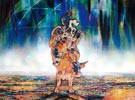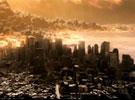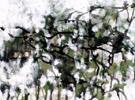Luo Xu:The Earth or the World?
By Barbara Pollack
I am a seed in the earth of Yunnan. Only on this piece of land can this seed take root, shoot up, blossom and bear fruit. I am fascinated by this piece of land; it is my home. Just like a womb, it is like my mother.
Luo Xu
Nearly a century ago, European artists flocked to Provence, the southern most region of France, to paint its lush vineyards, sparkling beaches and startling blue skies. It is the landscape that gave birth to Impressionism, and artists ranging from Cézanne and van Gogh to Picasso and Matisse took turns at translating its wild beauty into color and form. With its quaint villages and local customs, Provence was also a refuge from city life which ironically allowed these artists the time and space to experiment and become full-fledge modernists away from the pressures of modernity.
Now, one hundred years later, Yunnan Province has all the makings of a “Provence” for the 21st century—at least for Chinese artists. With its lush landscape, old-fashioned pace and diverse ethnic groups, Yunnan bears a strong resemblance to the French countryside that inspired so many artists. Already laying claim to the name of “Shangri-La,” Yunnan retains its quality as “a land that time forgot,” in stark contrast to the superhighways and skyscrapers filling up the rest of China.
But, most Chinese artists are not yet ready to turn away from the major art centers in Beijing and Shanghai to contemplate a more restive beauty in Yunnan. Most are not looking at a landscape per se, but the myriad of ways that industrialization is transforming the Chinese cityscape. Most are not willing to separate themselves from the mass or strike out in their own way. They are too anxious to join in movements, group shows and the like, especially the worldwide movement of contemporary art.
One artist, who like his European modernist predecessors, is willing to move away—“far from the maddening crowd”—and find his own way is Luo Xu, who returned to his homeland of Yunnan in order to restore his inspiration as an artist. Born in Mi’le, Yunnan in 1956, Luo Xu came of age as an artist at a time when it would have been impossible to imagine a Chinese artist having an independent career outside of government control. Like many at the time, he was assigned work in a porcelain factory at the age of 16 and five years later, was reassigned to a construction team. He dreamed of becoming an architect, but was defeated by the difficulty of higher mathematics. He tried his hand at several trades, including raising rabbits. Finally, in 1988, his nascent art work caught the attention of master-sculptor Qian Shao and Luo Xu followed his mentor to the Central Academy of Art in Beijing for a year of professional training. In 1992, he was ready to return to Yunnan and four years later, he began to build his remarkable artist’s sanctuary—the Earth Nest—a series of mud-packed mounds that house his studio, gallery, community center and home. Located outside Kunming, the nest is like Claude Monet’s beloved Giverny, a spot away from civilization that is nonetheless far more conducive to creative art making.
To me, the metropolis is just like a huge shopping mall, or a supermarket, rather than a place in which I can hibernate or seek food in spring time. It’s more like a freeway, by which you can get to your destination in a flash. I prefer to wander around on my donkey, without any doubt. Just imagine what it would be like if I rode my donkey on the freeway.
Luo Xu
Choosing donkeys over freeways goes against the grain of all the recent developments in China, when most seem impatient to join a 21st century even at the expense of throwing away the best of the past. Luo Xu’s choices, therefore, may seem outlandish, naïve, or even old-fashioned. Nothing could be further from the truth. Indeed, if you examine his nest in detail, many sophisticated references to contemporary design and to more traditional styles of homemaking are revealed. When he first started designing the nest, using little more than bamboo poles and string to sketch out his foundation, an architect warned the artist that the structure would never hold. Now, ten years later, this outcrop of buildings, some reaching 16 meters tall, is firmly in place. These boulder-like forms are reminiscent of the Stone Forest, the prehistoric rock formations just down the road from Luo Xu’s home that almost look like man-made sculptures. The rounded mounds are also downright anti-conformist, bristling against the blocks of square apartment houses that now are filling up Chinese cities. It is in keeping with previous architectural stabs at non-conformity, ranging from Frank Lloyd Wright’s Guggenheim Museum to Paolo Solari’s desert commune, Arcosanti. The womb supersedes more masculine forms of architecture and constitutes an alternative mode of housing that leads straight back to the roots of creation itself.
Likewise, Luo Xu’s artwork has often been described as the work of an “outsider” artist—a self-taught, naïve, savant—as if this artist is merely a madman and not a participant in the contemporary dialogue. Certainly, his work brims with his own personal obsessions, particularly his adoration of women’s legs. For sometime, he made large bronze sculptures based on the disembodied legs of chorus girls, full bulbous legs that surrealistically end in tiny delicate points. On the grounds of his enclave, there is Woman and Bull, an amalgamation of female and beast, with lovely legs protruding like tentacles out of the back of the beefy monster. Nearby, a windmill of legs, bright and shiny as a pinwheel, spins out of control. These legs are not practical but merely erotic, serving only to be subservient to Luo Xu’s male fantasies. Indeed, they are downright politically incorrect. And as such, they may indeed seem to be the vision of a madman or someone far outside the concerns of the contemporary art establishment.
It would be a mistake to interpret them as such. For as wild and untamable as these sculptures seem, they are also rooted in a love of kitsch, of porcelain dolls and souvenir items. They reflect a China that is too willing to accommodate the desires of the outside world, to provide porcelain and women that meet Westerners’ taste, to play up exoticism to heighten its culture’s allure to outsiders. Luo Xu may seem to be condoning this exercise in poor taste—okay, he admits that he adores women’s legs—but he also may be as savvy as Jeff Koons or Tom Wesselman, two American artists who exploit Americans’ bad taste to make widely appealing art. In China, Jeff Koons (whose work has been included in several biennials) would be widely known and appreciated for his oversized casts of household tchotskes of cartoon characters, animals, and busty women. His work makes it hard to guess if he, the artist, celebrates or criticizes this low-brow imagery. Wesselman, whose abstractions of women’s breasts and nipples are icons of American Pop, is probably less known in China where explicit sexual imagery is still relatively forbidden. That a Chinese artist is mining this territory—the erotic allure of blatantly sexist forms—is all the more remarkable. It means that Luo Xu is willing to claim the freedom long enjoyed by American artists: the freedom to celebrate bad taste, to celebrate bad motives, to celebrate what others may consider bad art, as a fundamental expression of an artist’s right to be himself.
The bending tree in the forest is different from what the other trees need in a park. The bending tree just shoots up and bears fruit in its own living environment, while the other trees grow along their own paths based on the rules. I AM the bending tree. I am incapable of straightening up to be that upright trunk.
Luo Xu
The double-irony in Luo Xu’s strategy is that while he has separated himself from the style and careerism of many Chinese contemporary artists, his work has attracted widespread support throughout the world. His stance is a performance, enacting the idiosyncrasies of a madman or hermit as a means of verifying his visionary art. But, he could not possibly be merely a madman or a hermit to win over so many audiences for his art forms, both in China and abroad. The reach of his work demonstrates that Luo Xu is making much more than a personal statement by choosing “legs” as a primary form. In China, his “legs” have been interpreted as commentary on foot binding, on the liberation of Chinese women from ancient modes of bondage and social castes, on the power of the state to control the private lives of its citizens. Outside China, the “legs” have been interpreted as personal, the product of a hyper-erotic gaze and proof of unbridled masculinity. Both interpretations ignore the sophistication of the art making underlying these works. Luo Xu has embraced morphing techniques from digital media, using Photoshop to turn legs into bombs, airplanes, and icons of power. He then retranslates these fantasies into three-dimensional forms that are then bronzed or fabricated in fiberglass. To create one work, therefore, he must combine an expertise in at least three media. He is also willing to risk that you, the viewer, will make fun of him; that you will miss the artist’s sense of humor and instead wind up laughing at him, not with him.
This is a bravery that comes from being willing to make a fool of oneself. Rather than placing himself on a pedestal, Luo Xu merely sets himself apart. It may be strange to think of a Chinese artist who already seeks refuge from art centers when less than a decade ago there were no such districts to show contemporary art works. It is stranger still to think of a Chinese artist declaring himself to be an “outsider,” when most contemporary Chinese artists are more concerned with breaking “in” to the contemporary art world, especially abroad. And, strangest of all, it is weird to find a Chinese artist taking up the modernist myth of the insane genius—think, Vincent van Gogh—when this ideology has barely taken root in China at all.




